THE VERY MANY ‘INNS OF THE GOOD SAMARITAN’
The twenty-fifth anniversary of the institution of the World Day of the Sick and the twentieth anniversary of the foundation of the National Office for Pastoral Care in Health
We thank the Lord for the journey that has been achieved in our time, for what has been done in favour of integral care for the sick, and for the generosity of so many men and women who have accepted the invitation of Jesus to visit him in the person of the sick (cf. Mt 25:36). These have been years marked by strong social and cultural changes, and today we can perceive a situation with lights and shadows. It is certainly the case that scientific research has advanced and we are grateful for the valuable results that have been achieved in the treatment – if not the defeat – of some pathologies. I hope that the same commitment will be assured as regards rare and neglected diseases, to which due attention is not always paid, with the attendant risk of generating further suffering. We also praise the Lord for the many health-care workers who, with learning and in a conscientious way, live their work as a mission: ministers of life and participants in the overflowing love of God the Creator. Every day their hands touch the suffering flesh of Christ and this is a great honour and a grave responsibility. We also rejoice at the presence of numerous volunteers who with generosity and expertise strive to alleviate and humanise the long and difficult days of so many sick and elderly people who are alone, especially the poor and indigent. And I pause here to give thanks for the witness of volunteers in Italy. This was a surprise for me. I would never have thought that I would find something like this! There are very many volunteers who work in this field and they are convinced of what they are doing. And this is the work of parish priests, of great Italian parish priests, who have known how to fight in this field. For me this has been a surprise and I thank God for this.
Together with the lights, however, there are some shadows and these run the risk of making the experience of our sick brothers and sisters worse. If there is one sector in which the throwaway culture makes us see clearly its painful consequences, it is precisely that of health care. When a sick person is not put at the centre of things and considered in his or her dignity, attitudes are engendered that can even lead to speculating on the misfortunes of other people. And this is very grave! We have to be vigilant, especially when patients are elderly and have strongly compromised health, and if they are affected by grave pathologies that are costly at the level of treatment or are particularly difficult, as is the case with psychiatric patients. The company model in the health-care world, if adopted indiscriminately, instead of optimising the resources that are available runs the risk of producing thrown-away humans. Optimising resources means using them in an ethical and supportive way and not penalising those patients who are most frail.
In the first place, there is the inviolable dignity of every human person from the moment of his or her conception until his or her final breath. Money alone should not direct political and administrative decisions which are called to safeguard the right to health upheld by the Constitution of Italy, nor the decisions of those who manage places of care. The growing health-care poverty of the poorest parts of the population, due specifically to difficulties in obtaining access to treatment and care, should not leave anyone indifferent and efforts should be multiplied to ensure that the rights of the weakest are protected.
The history of the Italian Church has known very many ‘inns of the Good Samaritan’ where suffering people have received the oil of comfort and the wine of hope. I am thinking in particular of the numerous Christian health-care institutions. While I express to their representatives who are present here my appreciation of the good that has been done, I encourage them to advance the creativity of charity that was specific to their Founders. In contemporary contexts, where the response to the request for health of the frailest shows itself to be increasingly difficult, do not hesitate, as well, to think anew about your works of charity in order to offer a sign of the mercy of God to the poorest who, with trust and hope, knock at the doors of your institutions. Amongst the goals that St. John Paul II gave to the World Day of the Sick, in addition to the promotion of the culture of life, there was also that of ‘involving…dioceses, Christian communities, religious families in pastoral care in health’. Very many sick people are in hospitals but many more are in their homes, and they are increasingly alone. I hope that they receive frequent visits so that they do not feel excluded from the community and can experience, because of the nearness of those who meet them, the presence of Christ who today passes by amidst the sick in body and spirit. Unfortunately, ‘the worst discrimination which the poor suffer’, and the sick are poor in health, ‘is the lack of spiritual care…they need God and we must not fail to offer them his friendship, his blessing, his word, the celebration of the sacraments and a journey of growth and maturity in the faith’ (Apostolic Exhortation, Evangelii gaudium, n. 200).
Sick people are precious members of the Church. With the grace of God and the intercession of Mary, Health of the Sick, may they become strong in weakness (cf. 2 Cor 12:10), and ‘receive the grace to fill up what is lacking in the sufferings of Christ for his body, the Church (cf. Col 1:24). For that body, in the image of the risen Lord’s own, keeps its wounds, the mark of a hard struggle, but they are wounds transfigured for ever by love’. Thank you!
SPEECH OF THE HOLY FATHER FRANCIS TO THOSE TAKING PART IN THE MEETING ORGANISED BY THE COMMISSION FOR CHARITY AND HEALTH OF THE ITALIAN BISHOPS’ CONFERENCE
Rome, 10 February 2017
THE PROVINCE OF INDIA
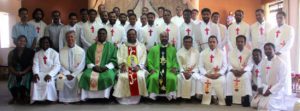 On Saturday 18 February, the first Provincial Chapter of the Camillian Province of India (18-22 February 2017) began, with the aim of assessing the PAST, reflecting on the PRESENT, and STRENGTHENING THE FUTURE.
On Saturday 18 February, the first Provincial Chapter of the Camillian Province of India (18-22 February 2017) began, with the aim of assessing the PAST, reflecting on the PRESENT, and STRENGTHENING THE FUTURE.
Thirty-five members of the Chapter were called to take part in this Chapter and another seven were invited to the specific sessions, amongst whom were the regional presidents of the Lay Camillian Family. The first activity was a spiritual talk presented by Rev. Dr. Xavier Manavath CMF, the vicar for the religious of the Archdiocese of Bangalore. He ended his talk with a celebration of the Eucharist.
ROME – THE CAMILLIANUM
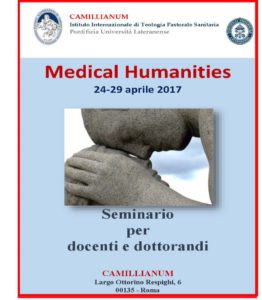 On 24-29 April 2017, in the aula magna of the Camillianum, the ‘medical humanities’ seminar will be held: disciplines of the humanities, exploring the complexity of anthropology, contribute to the practice of medicine which has the task of treating people, of re-establishing their health in a relational dimension nourished by trust and hope. The debate on the ‘medical humanities’ clarified the impossibility of opposing treating and taking care of, the efficacy of treatment and the quality of relationships.
On 24-29 April 2017, in the aula magna of the Camillianum, the ‘medical humanities’ seminar will be held: disciplines of the humanities, exploring the complexity of anthropology, contribute to the practice of medicine which has the task of treating people, of re-establishing their health in a relational dimension nourished by trust and hope. The debate on the ‘medical humanities’ clarified the impossibility of opposing treating and taking care of, the efficacy of treatment and the quality of relationships.
THE TWENTY-FIFTH WORLD DAY OF THE SICK– 11 February 2017
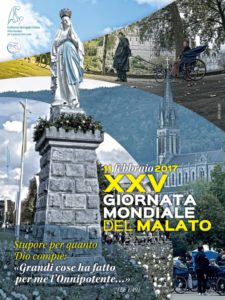 We here share with you the pictures and the programmes of the World Day of the Sick as celebrated in the various Camillian communities of the world.
We here share with you the pictures and the programmes of the World Day of the Sick as celebrated in the various Camillian communities of the world.
Amazement at what God has accomplished:
“The Almighty has done great things for me…” (Lk 1:49)
THE PROVINCE OF BRAZIL
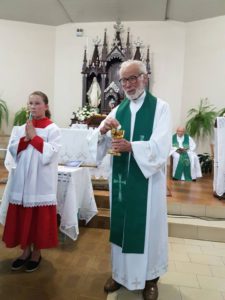 The Camillian Province of Brazil has celebrated the ninetieth birthday of its religious Fr. Carlos Alberto Pigatto and the first religious profession of two if its members: Edson da Silva Piers and Gabriel Andreson Barbosa.
The Camillian Province of Brazil has celebrated the ninetieth birthday of its religious Fr. Carlos Alberto Pigatto and the first religious profession of two if its members: Edson da Silva Piers and Gabriel Andreson Barbosa.
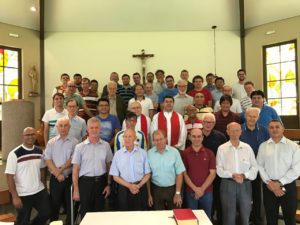 We also share with you a snap shot of those taking part in the Provincial Chapter of Brazil which took place on 1-4 February of this year in San Paolo (Brazil).
We also share with you a snap shot of those taking part in the Provincial Chapter of Brazil which took place on 1-4 February of this year in San Paolo (Brazil).
MACAPÀ
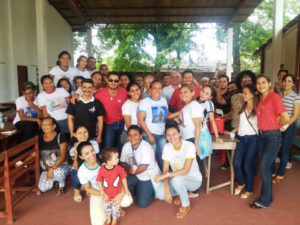 The Parish of Santa Teresa, in cooperation with the ‘Pauline’ libraries, on 19 January 2017 organised a meeting for formation for all the catechists of the parish (READ HERE).
The Parish of Santa Teresa, in cooperation with the ‘Pauline’ libraries, on 19 January 2017 organised a meeting for formation for all the catechists of the parish (READ HERE).
ROME – ‘THE CHURCH OF ST MARY MAGDALENE’
Event to commemorate the conversion of St. Camillus
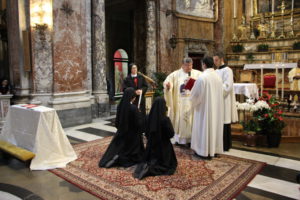 On 2 February, the Superior General, Fr. Leocir Pessini, presided over a solemn celebration of the Eucharist in the Church of St. Mary Magdalene in Campo Marzio on the occasion of the one hundred and twenty-fifth anniversary of the foundation of the Order of the Daughters of St. Camillus. During the liturgy, two Daughters of St. Camillus, Sr. Fidelia (from Peru) and Sr. Gelane (from the Philippines), made their perpetual profession of religious vows.
On 2 February, the Superior General, Fr. Leocir Pessini, presided over a solemn celebration of the Eucharist in the Church of St. Mary Magdalene in Campo Marzio on the occasion of the one hundred and twenty-fifth anniversary of the foundation of the Order of the Daughters of St. Camillus. During the liturgy, two Daughters of St. Camillus, Sr. Fidelia (from Peru) and Sr. Gelane (from the Philippines), made their perpetual profession of religious vows.
TAIWAN
 On 6-12 January 2017, Fr. Henry Angupa Bosoen II accompanied a group of nurses to continental China to care for lepers.
On 6-12 January 2017, Fr. Henry Angupa Bosoen II accompanied a group of nurses to continental China to care for lepers.
On 8 January 2017, the Chapter of the Delegation was held with a presentation of the annual budget and the annual accounts.
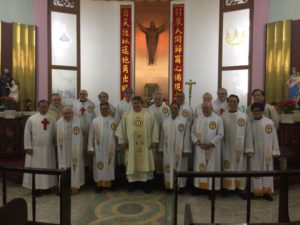 The Superior General, Fr. Leocir Pessini, during the period of his visit to Thailand (6-29 January 2017) and to Vietnam (8-11 January 2017), also paid a visit to the religious of the Delegation of Taiwan (19-22 January 2017). During the visit the new geriatric section named after Br. Renato Marinello was inaugurated. Also present were Fr. Rolly Fernandez, the Provincial Superior of the Philippines; Fr. Giovanni Contarin from Thailand; Fr. Mario Didonè, a chaplain of the hospital of Padua; and Don Matteo Ragazzo, the former parish priest of Cà Onorai (Padua), the town where three of our religious were born: Fr. Antonio, Fr. Giuseppe and Fr. Mario Didonè.
The Superior General, Fr. Leocir Pessini, during the period of his visit to Thailand (6-29 January 2017) and to Vietnam (8-11 January 2017), also paid a visit to the religious of the Delegation of Taiwan (19-22 January 2017). During the visit the new geriatric section named after Br. Renato Marinello was inaugurated. Also present were Fr. Rolly Fernandez, the Provincial Superior of the Philippines; Fr. Giovanni Contarin from Thailand; Fr. Mario Didonè, a chaplain of the hospital of Padua; and Don Matteo Ragazzo, the former parish priest of Cà Onorai (Padua), the town where three of our religious were born: Fr. Antonio, Fr. Giuseppe and Fr. Mario Didonè.
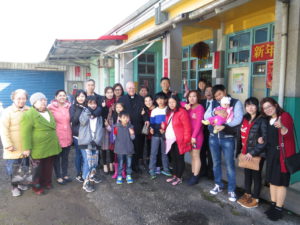 The traditional ceremony for the return of our employees/co-workers after the celebrations for the Chinese New Year (27 January 2017) was celebrated on 3 February.
The traditional ceremony for the return of our employees/co-workers after the celebrations for the Chinese New Year (27 January 2017) was celebrated on 3 February.
The Provincial chapter of the Philippines, of which Taiwan is a Delegation, was celebrated on 5-10 February. Fr. Jojio Eloja, a religious of the Delegation of Taiwan, received the most votes in the slate for the appointment of the new Provincial Superior of the Philippines.
The World Day of the Sick was celebrated in a solemn way on 11 February, with the sacrament of the anointing of the sick which was given to a number of patients of our help centres.
THE PROVINCE OF THE PHILIPPINES
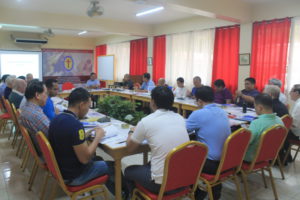 The Chapter of the Camillian Province of the Philippines was held in Manila-Quezon City with reflections on our past, the quality of our identity, and how to strengthen our future in the light of the statutes of the Province. Twenty-six (24 perpetually professed religious and 2 temporary professed religious) religious took part in this Chapter. The members of the Chapter came from the Delegations of Australia, of Indonesia, and of Taiwan and from the Province of the Philippines. The Chapter was celebrated at the St. Camillus Pastoral Centre on 6-10 February 2017. The principal discussion focused on the statutes of the Province which had been recently revised and updated.
The Chapter of the Camillian Province of the Philippines was held in Manila-Quezon City with reflections on our past, the quality of our identity, and how to strengthen our future in the light of the statutes of the Province. Twenty-six (24 perpetually professed religious and 2 temporary professed religious) religious took part in this Chapter. The members of the Chapter came from the Delegations of Australia, of Indonesia, and of Taiwan and from the Province of the Philippines. The Chapter was celebrated at the St. Camillus Pastoral Centre on 6-10 February 2017. The principal discussion focused on the statutes of the Province which had been recently revised and updated.
ROME –THE DAUGHTERS OF ST CAMILLUS
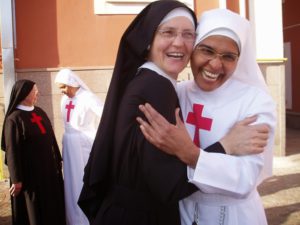 The Daughters of St. Camillus celebrated the one hundred and twenty-fifth anniversary of the foundation of their Institute. We here share with readers the message of Mother Zelia Andrighetti, the Mother Superior of the Institute.
The Daughters of St. Camillus celebrated the one hundred and twenty-fifth anniversary of the foundation of their Institute. We here share with readers the message of Mother Zelia Andrighetti, the Mother Superior of the Institute.
THE PROVINCE OF SICILY AND NAPLES
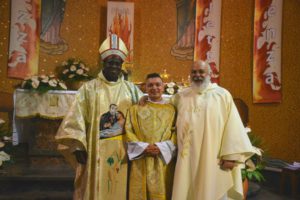 The young Camillian religious Giuseppe Salvatore Pontillo was ordained a deacon on 16 February of this year at the chapel of the Monaldi Hospital of Naples. The celebration was presided over by our religious Msgr. Prosper Kontiebo, the Bishop of Tenkodogo, Burkina Faso.
The young Camillian religious Giuseppe Salvatore Pontillo was ordained a deacon on 16 February of this year at the chapel of the Monaldi Hospital of Naples. The celebration was presided over by our religious Msgr. Prosper Kontiebo, the Bishop of Tenkodogo, Burkina Faso.
KENYA
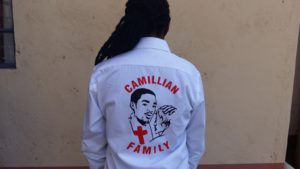 After forty years of Camillian ministry in Kenya, the Order of the Ministers of the Sick and the Great Family of St. Camillus are happy to have reaped (this year) an abundant harvest: in just one day twenty-one people joined the Lay Camillian Family. This took place on 4 February 2017, at the time of the commemoration of the conversion of St. Camillus.
After forty years of Camillian ministry in Kenya, the Order of the Ministers of the Sick and the Great Family of St. Camillus are happy to have reaped (this year) an abundant harvest: in just one day twenty-one people joined the Lay Camillian Family. This took place on 4 February 2017, at the time of the commemoration of the conversion of St. Camillus.
KENYA – Karungu
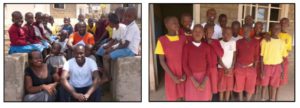 The LDS (long-distance support) group of the We World Kenya Foundation arrived in Karungu to update the dossiers of the children who receive long-distance support. This group will remain in Karungu for four months and will visit all those primary schools that work with our Camillian religious.
The LDS (long-distance support) group of the We World Kenya Foundation arrived in Karungu to update the dossiers of the children who receive long-distance support. This group will remain in Karungu for four months and will visit all those primary schools that work with our Camillian religious.
PUBLISHING NEWS
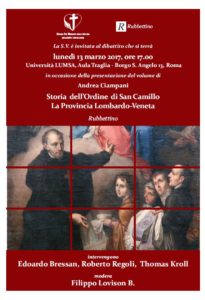 Storia dell’ordine di San Camillo – La Provincia Lombardo-Veneta (‘A History of the Order of St. Camillus – the Province of Lombardy and Veneto’)
Storia dell’ordine di San Camillo – La Provincia Lombardo-Veneta (‘A History of the Order of St. Camillus – the Province of Lombardy and Veneto’)
On 13 March 2017, at 17.00, at LUMSA University of Rome, the launch will be held of the new book of the series ‘A History of the Order of St. Camillus’ on the Province of Lombardy and Veneto. This is the latest volume of the series that was begun to celebrate the fourth centenary of the death of St. Camillus.
The complete series is made up of nine works:
Aspetti e problemi della storia dell’ordine di San Camillo (‘Aspects and Problems of the History of the Order of St. Camillus’).
Storia dell’ordine di San Camillo – La Provincia francese (‘A History of the Order of St. Camillus – the Province of France’).
Storia dell’ordine di San Camillo – La Provincia spagnola (‘A History of the Order of St. Camillus – the Province of Spain’).
Storia dell’ordine di San Camillo – La Provincia tedesca (‘A History of the Order of St. Camillus – the Province of Germany’).
Storia dell’ordine di San Camillo – La Provincia romana (‘A History of the Order of St. Camillus – the Province of Rome’).
Storia dell’ordine di San Camillo – La Provincia piemontese (‘A History of the Order of St. Camillus – the Province of Piedmont’).
Storia dell’ordine di San Camillo – La Provincia siculo napoletana (‘A History of the Order of St. Camillus – the Province of Sicily and Naples’).
San Camillo de Lellis e i suoi amici. Ordini religiosi e arte tra Rinascimento e Barocco (‘St. Camillus de Lellis and his Friends. Religious Orders and Art between the Renaissance and the Baroque’).
The New Charter for Health Care Workers
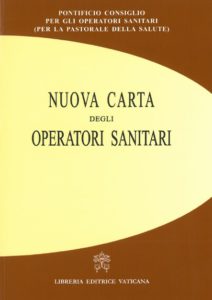 The New Charter for Health Care Workers was presented in the Vatican on 6 February 2017. This is a sort of compendium of practice and doctrine that has updated the previous edition of 1995. This document is divided into three chief sections – generating, living, and dying – in which the Church emphasises her constant position on great ethical subjects in the light of the new ‘challenges’ that scientific progress poses to contemporary man.
The New Charter for Health Care Workers was presented in the Vatican on 6 February 2017. This is a sort of compendium of practice and doctrine that has updated the previous edition of 1995. This document is divided into three chief sections – generating, living, and dying – in which the Church emphasises her constant position on great ethical subjects in the light of the new ‘challenges’ that scientific progress poses to contemporary man.
Professor Antonio Gioacchino Spagnolo, the Director of the Institute of Bioethics and Medical Humanities of the A. Gemelli Faculty of Medicine and Surgery of the Catholic University of the Sacred Heart of Rome, spoke at length about the 150 pages of this New Charter, which takes the place of the Charter published in 1995.
Here is his complete speech:
‘The advances of biomedical research and the new socio/health-care realities that have taken place after 1994, like the declarations of the Magisterium of the Catholic Church in the field of the life and health sciences (those of the pontificates of John Paul II, of Benedict XVI, and of Pope Francis, the documents of the Congregation for the Doctrine of the Faith and of the Pontifical Academy for Life), made necessary a revision and updating of the Charter for Health Care Workers. This Charter, however, has conserved the original structure as an instrument for a serious grounding and ongoing formation at an ethical level of health-care workers in order to maintain their due professional competence and their vocation to being ministers of life.
First of all, attention at the outset is addressed to a broader spectrum of people involved in the biomedical field. Side by side with the classic professional health-care figures (medical, nursing and auxiliary personnel) also considered are other figures who in various capacities work in the world of health and health care, such as biologists, pharmacists, local health-care workers, administrators, legislators in the field of health care, and workers in the public and private sectors.
Some new articles in the text relate specifically to them and of them is requested a special responsibility in the performance of their service. All of these workers perform their daily practice in an interpersonal relationship that is marked by the trust of a person who is marked by suffering and illness and who turns to the expertise and the conscience of a health-care worker who comes to assist and treat them.
The Charter seeks to sustain the ethical faithfulness of health-care workers in their choices and behaviour, in which their service to life takes concrete form, and this faithfulness is outlined following the stages of human existence: generating, living, and dying, seen as moments of ethical-pastoral reflections.
In the section on generating, the criteria for treating infertility and natural methods not only for the regulation of fertility but also for obtaining a pregnancy are better specified. Also inserted is an article on the freeing of ovary tissue (art. 38), an ethically sustainable response in cases of cancer therapies that can alter the fertility of women.
The new attempts at the generation of humans in a laboratory are then taken into consideration (art. 39): between human and animal gametes, the gestation of human embryos in animal or artificial wombs, the asexual reproduction of human beings through twin fission, cloning, parthenogenesis or similar techniques.
These are all procedures that are in contrast with the human dignity of an embryo and procreation and as such they should be seen as being morally unacceptable.
As regards prenatal diagnoses, which are acceptable in some conditions, pre-implant diagnosis is instead stigmatised (art. 36) as being an expression of a eugenic mentality which legitimises selective abortion to impede the birth of children who have various illnesses.
In the section on living, the Church’s constant position on abortion is confirmed with the insertion of new articles on embryo reduction, interception, anti-gestation, anencephalic foetuses, ectopic pregnancies, and the protection of the right to life (articles 51-59).
Attention is also paid to the subject of prevention and vaccines which has been the subject of recent public debate (articles 69-70). The reference to gene therapy and regenerative medicine is of contemporary relevance from a scientific point of view (articles 80-82).
At a social level, the Charter dwells upon the subject of access to medical products and available technologies for the population (art. 91), access which still today, above all in developing countries (and above all those characterised by political instability or scarce economic resources), is not assured to large parts of the population. This is especially the case as regards so-termed ‘rare diseases’ and ‘neglected diseases’, with which is associated the concept of ‘orphan medical products’ (art. 92).
Health-care workers and their professional associations are asked to become promoters of a sensitisation of institutions, of care-providing agencies and of the health-care industry so that the right to protection of health is extended to the whole of the population, thereby achieving health-care justice, with a safeguarding of the sustainability of both research and health-care systems.
Also new is the reference to the involvement in experimentation of minors or adults who are incapable of deciding, vulnerable individuals, and women of the fertile age in situations of emergency.
Lastly, in this section the role of consultation in clinical ethics is highlighted (art. 140). This consultation can help in the identification of ethical conflict and doubts that individual health-care workers, patients and their family relatives may have in clinical practice, thereby facilitating their solution through diagnostic-therapeutic decisions shared at the bedside of patients within the context of the values specific to medicine and ethics.
In the section of dying, attention is paid to the approach that should be adopted towards patients during the terminal stage of an illness: this is a setting for a testing of the professionalism and ethical responsibility of health-care workers (art. 145).
In this field, an aspect of great contemporary relevance addressed by the Charter – a subject which in recent days has been much discussed in the Italian Parliament – is the reference to a prior expression of a patient’s wishes (art. 150) about forms of treatment that he or she would or would not like to receive were – during an illness or because of unforeseen traumas – he or she no longer able to express consent. The Charter states that the reasonable wishes or legitimate interests of the patient must always be respected, but the medical doctor is not a mere executor, given that he or she conserves the right not to follow wishes that are not in agreement with his or her own conscience.
An equally relevant subject is that of the nutrition and hydration due to a patient, also when they are artificially administered (art. 152). These are seen as belonging to the basic forms of treatment due to a dying person when they are not too burdensome or have no benefit. Their unjustified suspension can mean an authentic act of euthanasia, but they are obligatory to the extent that, and as long as, they are shown to achieve their specific goal, which is to obtain hydration and nutrition for the patient. The ethical acceptability of deep palliative sedation during the stages near to the moment of death is confirmed and this should be carried out according to correct ethical protocols and be subject to constant monitoring.
In the background to this section is the defence of the dignity of dying (art. 149) in the sense of respecting the patient during the final stage of life, excluding both bringing death forward (euthanasia) and putting it off through the use of so-termed ‘exaggerated treatment’.
It is certainly the case that this Charter cannot be seen as exhaustive as regards all the problems and questions that impose themselves in the field of health and illness. But it has been produced in order to offer guidelines that are as clear as possible for the ethical problems that have to be addressed in the world of health and health care in general in harmony with the teachings of Christ and the Magisterium of the Church’.
THE PROVINCE OF THAILAND AND THE DELEGATION OF VIETNAM
The text of the message of the Superior General to the Camillians of the Province of Thailand and of the Delegation of Vietnam following the recent pastoral visit (Bangkok, Thailand, Ho Chi Minh City ,Vietnam) of 7- 28 January 2017.
THE CONSTITUTION AND GENERAL STATUTES – TRANSLATIONS INTO TWO FURTHER LANGUAGES
 Translations into Thai and Portuguese, by the respective Provinces of Thailand and Portugal, of the Constitution and General Statutes have been completed. The Superior General, in conformity with GS, n. 158, has approved these translations and authorised their publication and dissemination amongst the religious of the Order.
Translations into Thai and Portuguese, by the respective Provinces of Thailand and Portugal, of the Constitution and General Statutes have been completed. The Superior General, in conformity with GS, n. 158, has approved these translations and authorised their publication and dissemination amongst the religious of the Order.
DIARY OF THE SUPERIOR GENERAL AND THE MEMBERS OF THE GENERAL CONSULTA
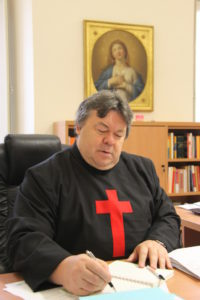 On 18-25 February 2017, Fr. Aris Miranda, after being in Nepal for a final assessment of the emergency interventions of CADIS after the earthquake in that country, was in India to take part in the Provincial Chapter of that religious Province.
On 18-25 February 2017, Fr. Aris Miranda, after being in Nepal for a final assessment of the emergency interventions of CADIS after the earthquake in that country, was in India to take part in the Provincial Chapter of that religious Province.
On 20 February to 1 March 2017, Fr. Leocir Pessini and Fr. Laurent Zoungrana will visit the Camillian religious of Indonesia (formation section). A series of papers will be offered to the local seminarians on pastoral care in health and the Camillian charism.
On 27 February to 1 March 2017, Fr. Gianfranco Lunardon will attend the Chapter of the Province of Spain.
On 3-18 March 2017, Br. Ignacio Santaolalla and Fr. Laurent Zoungrana will attend the Chapter of the Vice-Province of Benin-Togo.
On 5-10 March 2017, Fr. Leocir Pessini will attend the Chapter of the Province of Sicily and Naples.
INTERNATIONAL APPOINTMENTS OF THE ORDER FOR THE YEAR 2017
International meeting of Camillian parish priests in San Paolo in Brazil, on 19-24 April 2017.
The Province of Brazil is thanked for taking responsibility for all of the logistical organisation of the event.
Course of formation for the Major Superiors of the Order
On 24 June to 2 July 2017 2017 a meeting – a course of formation – of the Major Superiors of the Order will be organised in Rome at the generalate house of the Brothers of Christian Schools.
International Meeting of the Providers of Formation of the Order
On 13-19 October 2017, in Rome, an international meeting of providers of formation and animators of vocations of the Order will be held. The focus of the meeting will be dialogue and sharing in order to achieve an updating of the handbook on formation.
DECEASED RELIGIOUS
The religious of the Province of Poland have announced the death of the Camillian religious Fr. Franciszek Pilarski (born on 5 December 1949) in Warsaw on 26 January 2017. Let us remember Fr. Franciszek in our prayers.
The Institute of the Daughters of St. Camillus have announced the death of Sister Mariana Schmidt ANDALUZ, which took place on 11 February 2017 in Lima, Peru; of Sister Concetta Strano, which took place on 15 February 2017 in S. Alfio di Catania; and of Sister Nazzarena Pozzoli (at the age of 97 after 64 years of religious profession).
MESSAGE OF HIS HOLINESS POPE FRANCIS FOR LENT 2017
“The Word is a gift. Other persons are a gift”
Dear Brothers and Sisters,
 Lent is a new beginning, a path leading to the certain goal of Easter, Christ’s victory over death. This season urgently calls us to conversion. Christians are asked to return to God “with all their hearts” (Joel 2:12), to refuse to settle for mediocrity and to grow in friendship with the Lord. Jesus is the faithful friend who never abandons us. Even when we sin, he patiently awaits our return; by that patient expectation, he shows us his readiness to forgive (cf. Homily, 8 January 2016).
Lent is a new beginning, a path leading to the certain goal of Easter, Christ’s victory over death. This season urgently calls us to conversion. Christians are asked to return to God “with all their hearts” (Joel 2:12), to refuse to settle for mediocrity and to grow in friendship with the Lord. Jesus is the faithful friend who never abandons us. Even when we sin, he patiently awaits our return; by that patient expectation, he shows us his readiness to forgive (cf. Homily, 8 January 2016).
Lent is a favourable season for deepening our spiritual life through the means of sanctification offered us by the Church: fasting, prayer and almsgiving. At the basis of everything is the word of God, which during this season we are invited to hear and ponder more deeply. I would now like to consider the parable of the rich man and Lazarus (cf. Lk 16:19-31). Let us find inspiration in this meaningful story, for it provides a key to understanding what we need to do in order to attain true happiness and eternal life. It exhorts us to sincere conversion.
1. The other person is a gift
The parable begins by presenting its two main characters. The poor man is described in greater detail: he is wretched and lacks the strength even to stand. Lying before the door of the rich man, he fed on the crumbs falling from his table. His body is full of sores and dogs come to lick his wounds (cf. vv. 20-21). The picture is one of great misery; it portrays a man disgraced and pitiful.
The scene is even more dramatic if we consider that the poor man is called Lazarus: a name full of promise, which literally means God helps. This character is not anonymous. His features are clearly delineated and he appears as an individual with his own story. While practically invisible to the rich man, we see and know him as someone familiar. He becomes a face, and as such, a gift, a priceless treasure, a human being whom God loves and cares for, despite his concrete condition as an outcast (cf. Homily, 8 January 2016).
Lazarus teaches us that other persons are a gift. A right relationship with people consists in gratefully recognizing their value. Even the poor person at the door of the rich is not a nuisance, but a summons to conversion and to change. The parable first invites us to open the doors of our heart to others because each person is a gift, whether it be our neighbour or an anonymous pauper. Lent is a favourable season for opening the doors to all those in need and recognizing in them the face of Christ. Each of us meets people like this every day. Each life that we encounter is a gift deserving acceptance, respect and love. The word of God helps us to open our eyes to welcome and love life, especially when it is weak and vulnerable. But in order to do this, we have to take seriously what the Gospel tells us about the rich man.
2. Sin blinds us
The parable is unsparing in its description of the contradictions associated with the rich man (cf. v. 19). Unlike poor Lazarus, he does not have a name; he is simply called “a rich man”. His opulence was seen in his extravagant and expensive robes. Purple cloth was even more precious than silver and gold, and was thus reserved to divinities (cf. Jer 10:9) and kings (cf. Jg 8:26), while fine linen gave one an almost sacred character. The man was clearly ostentatious about his wealth, and in the habit of displaying it daily: “He feasted sumptuously every day” (v. 19). In him we can catch a dramatic glimpse of the corruption of sin, which progresses in three successive stages: love of money, vanity and pride (cf. Homily, 20 September 2013).
The Apostle Paul tells us that “the love of money is the root of all evils” (1 Tim 6:10). It is the main cause of corruption and a source of envy, strife and suspicion. Money can come to dominate us, even to the point of becoming a tyrannical idol (cf. Evangelii Gaudium, 55). Instead of being an instrument at our service for doing good and showing solidarity towards others, money can chain us and the entire world to a selfish logic that leaves no room for love and hinders peace.
The parable then shows that the rich man’s greed makes him vain. His personality finds expression in appearances, in showing others what he can do. But his appearance masks an interior emptiness. His life is a prisoner to outward appearances, to the most superficial and fleeting aspects of existence (cf. ibid., 62).
The lowest rung of this moral degradation is pride. The rich man dresses like a king and acts like a god, forgetting that he is merely mortal. For those corrupted by love of riches, nothing exists beyond their own ego. Those around them do not come into their line of sight. The result of attachment to money is a sort of blindness. The rich man does not see the poor man who is starving, hurting, lying at his door.
Looking at this character, we can understand why the Gospel so bluntly condemns the love of money: “No one can be the slave of two masters: he will either hate the first and love the second, or be attached to the first and despise the second. You cannot be the slave both of God and of money” (Mt 6:24).
3. The Word is a gift
The Gospel of the rich man and Lazarus helps us to make a good preparation for the approach of Easter. The liturgy of Ash Wednesday invites us to an experience quite similar to that of the rich man. When the priest imposes the ashes on our heads, he repeats the words: “Remember that you are dust, and to dust you shall return”. As it turned out, the rich man and the poor man both died, and the greater part of the parable takes place in the afterlife. The two characters suddenly discover that “we brought nothing into the world, and we can take nothing out of it” (1 Tim 6:7).
We too see what happens in the afterlife. There the rich man speaks at length with Abraham, whom he calls “father” (Lk 16:24.27), as a sign that he belongs to God’s people. This detail makes his life appear all the more contradictory, for until this moment there had been no mention of his relation to God. In fact, there was no place for God in his life. His only god was himself.
The rich man recognizes Lazarus only amid the torments of the afterlife. He wants the poor man to alleviate his suffering with a drop of water. What he asks of Lazarus is similar to what he could have done but never did. Abraham tells him: “During your life you had your fill of good things, just as Lazarus had his fill of bad. Now he is being comforted here while you are in agony” (v. 25). In the afterlife, a kind of fairness is restored and life’s evils are balanced by good.
The parable goes on to offer a message for all Christians. The rich man asks Abraham to send Lazarus to warn his brothers, who are still alive. But Abraham answers: “They have Moses and the prophets, let them listen to them” (v. 29). Countering the rich man’s objections, he adds: “If they will not listen either to Moses or to the prophets, they will not be convinced even if someone should rise from the dead” (v. 31).
The rich man’s real problem thus comes to the fore. At the root of all his ills was the failure to heed God’s word. As a result, he no longer loved God and grew to despise his neighbour. The word of God is alive and powerful, capable of converting hearts and leading them back to God. When we close our heart to the gift of God’s word, we end up closing our heart to the gift of our brothers and sisters.
Dear friends, Lent is the favourable season for renewing our encounter with Christ, living in his word, in the sacraments and in our neighbour. The Lord, who overcame the deceptions of the Tempter during the forty days in the desert, shows us the path we must take. May the Holy Spirit lead us on a true journey of conversion, so that we can rediscover the gift of God’s word, be purified of the sin that blinds us, and serve Christ present in our brothers and sisters in need. I encourage all the faithful to express this spiritual renewal also by sharing in the Lenten Campaigns promoted by many Church organizations in different parts of the world, and thus to favour the culture of encounter in our one human family. Let us pray for one another so that, by sharing in the victory of Christ, we may open our doors to the weak and poor. Then we will be able to experience and share to the full the joy of Easter.
From the Vatican, 18 October 2016
FRANCIS



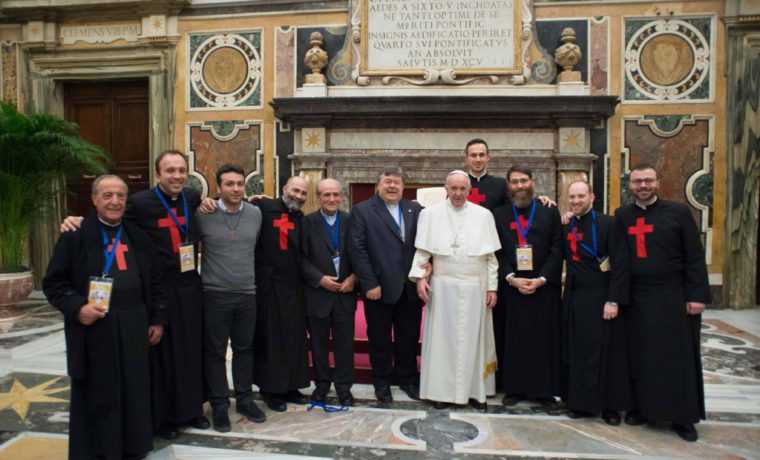











Camillians on Facebook
Camillians on Twitter
Camillians on Instagram